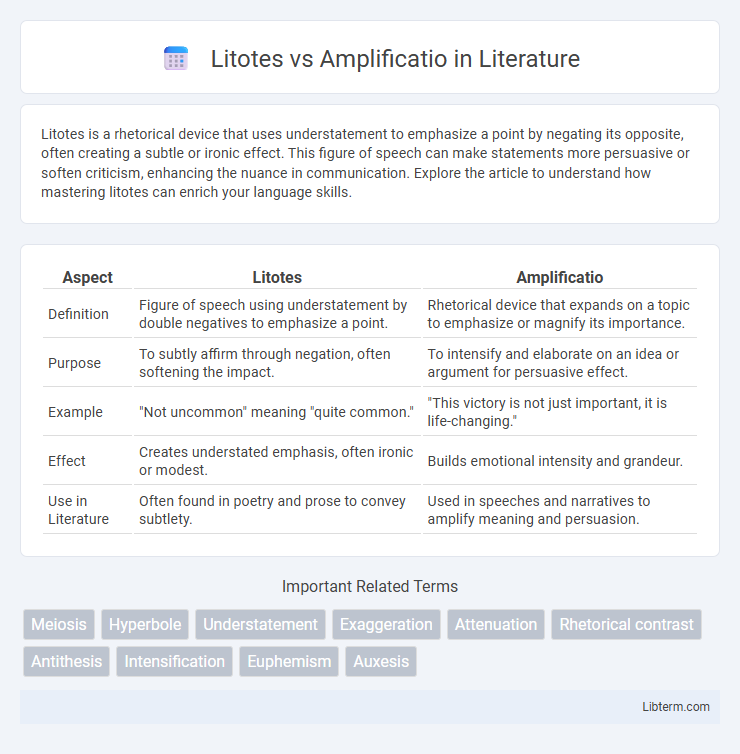Litotes is a rhetorical device that uses understatement to emphasize a point by negating its opposite, often creating a subtle or ironic effect. This figure of speech can make statements more persuasive or soften criticism, enhancing the nuance in communication. Explore the article to understand how mastering litotes can enrich your language skills.
Table of Comparison
| Aspect | Litotes | Amplificatio |
|---|---|---|
| Definition | Figure of speech using understatement by double negatives to emphasize a point. | Rhetorical device that expands on a topic to emphasize or magnify its importance. |
| Purpose | To subtly affirm through negation, often softening the impact. | To intensify and elaborate on an idea or argument for persuasive effect. |
| Example | "Not uncommon" meaning "quite common." | "This victory is not just important, it is life-changing." |
| Effect | Creates understated emphasis, often ironic or modest. | Builds emotional intensity and grandeur. |
| Use in Literature | Often found in poetry and prose to convey subtlety. | Used in speeches and narratives to amplify meaning and persuasion. |
Understanding Litotes: Definition and Origins
Litotes is a figure of speech involving deliberate understatement by using double negatives or negating the opposite, often to convey modesty or subtle emphasis. Originating from ancient Greek rhetoric, its name derives from the Greek word litotes (litotes), meaning simplicity or plainness, highlighting its role in understatement. Unlike Amplificatio, which enhances or expands an idea for emphasis, Litotes relies on restrained expression to achieve persuasive effect.
What is Amplificatio? Exploring its Meaning
Amplificatio is a rhetorical device used to expand on an idea by adding detail or emphasis to enhance its impact, creating a more persuasive or vivid expression. Unlike litotes, which uses understatement through double negatives to convey a subtle meaning, amplificatio magnifies the importance or intensity of a subject. This technique is commonly found in classical rhetoric and literature to reinforce arguments or elaborate descriptions for greater effect.
Historical Contexts of Litotes and Amplificatio
Litotes originated in ancient Greek and Latin rhetoric as a form of understatement used to convey modesty or irony, exemplified in classical texts where minimizing language enhanced persuasive subtlety. Amplificatio emerged in Roman rhetorical tradition, particularly in Cicero's and Quintilian's works, as an art of stylistic expansion used to intensify arguments and evoke emotional responses in speeches and writings. Both devices played crucial roles in shaping classical rhetoric's balance between restraint and exaggeration, influencing subsequent Western literary and argumentative techniques.
Structural Differences: Litotes vs Amplificatio
Litotes employs understatement by using double negatives or negating the opposite to create a subtle affirmation, often resulting in a concise and indirect expression. Amplificatio expands and intensifies the description, lengthening the statement to add emphasis and detail for heightened emotional or persuasive effect. The structural difference lies in Litotes' minimalist, restrained form contrasted with Amplificatio's elaborate and extended exposition.
Semantic Impact: Understatement vs Magnification
Litotes employs understatement to create a subtle, often ironic effect by negating the opposite, enhancing the emphasis through minimalism and restraint. Amplificatio magnifies details or emotions to intensify the message, invoking a stronger, more dramatic response. The semantic impact of litotes lies in its nuanced moderation, while amplificatio drives forceful emphasis and expansive elaboration.
Literary Examples of Litotes in Action
Litotes employs deliberate understatement by using negation to express a positive, as exemplified in Shakespeare's Julius Caesar with the phrase "not too bad" to mean "good." In contrast, Amplificatio expands on a statement for emphasis, often elaborating details to magnify meaning. Classic literary instances of litotes include Hemingway's "He's not the happiest person" and Orwell's "It was no small feat," strategically softening praise to enhance rhetorical effect.
Amplificatio in Rhetorical Mastery: Key Illustrations
Amplificatio is a powerful rhetorical device that intensifies the importance or magnitude of an idea through elaboration and detail, making arguments more persuasive and vivid. For example, Cicero's speeches often employed amplificatio to magnify the stakes of political conflict, enhancing emotional appeal and urgency. In contrast, Litotes uses understatement by negating the opposite, but amplificatio's strength lies in its ability to expand and elevate discourse for rhetorical mastery.
Effects on Tone and Reader Perception
Litotes employs understatement by negating the opposite, creating a subtle, often ironic tone that can evoke understatement and encourage readers to infer deeper meaning. Amplificatio uses elaborate expansion to emphasize and magnify a subject, resulting in a dramatic, persuasive tone that heightens emotional engagement and captures the reader's attention. The contrast between Litotes' restraint and Amplificatio's exaggeration shapes reader perception by either inviting reflection or intensifying impact.
When to Use Litotes or Amplificatio in Writing
Litotes is effective when aiming to convey modesty or understatement, especially to create irony or soften criticism, making statements more subtle and nuanced. Amplificatio is best used to emphasize a point by expanding on details, enhancing the emotional impact or clarity of the argument through elaboration. Writers should choose Litotes to downplay intensity and Amplificatio to heighten the significance of their message.
Conclusion: Balancing Understatement and Emphasis
Litotes employs understatement by using negation to convey affirmation subtly, creating a restrained yet impactful effect, while Amplificatio enhances ideas through deliberate elaboration and emphasis to magnify the message's significance. Effective communication often requires balancing Litotes' subtlety with Amplificatio's intensity to avoid misinterpretation or overstatement. Strategic use of both rhetorical devices enriches expression, allowing writers to nuancedly modulate tone and persuasive force in their conclusions.
Litotes Infographic

 libterm.com
libterm.com